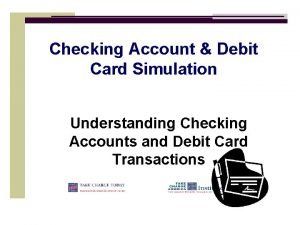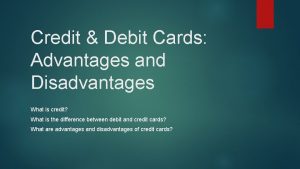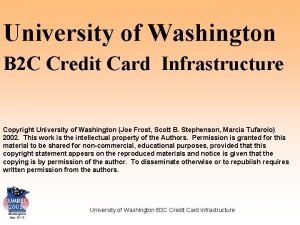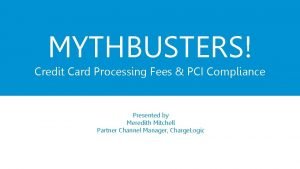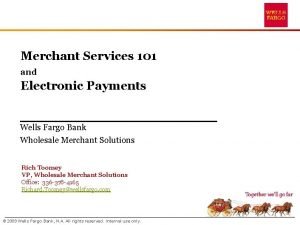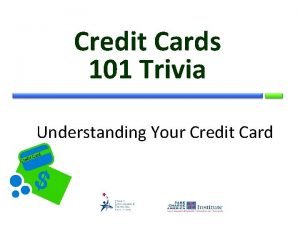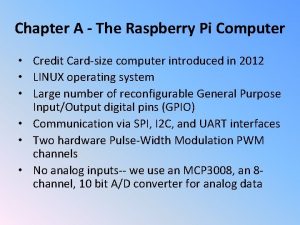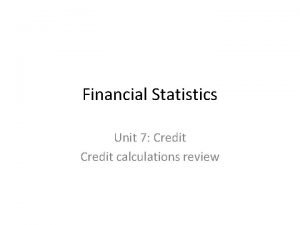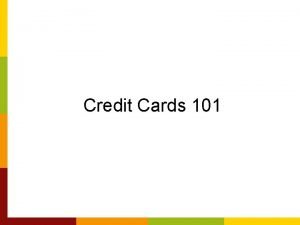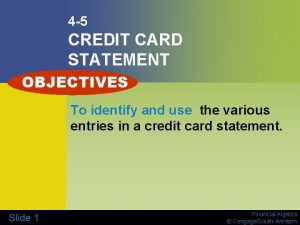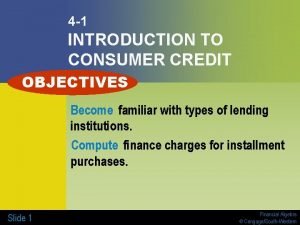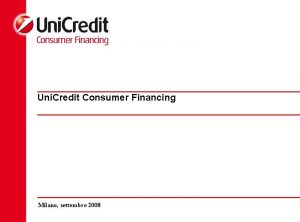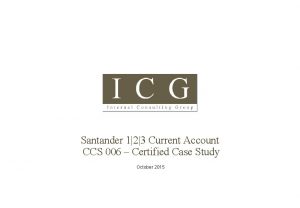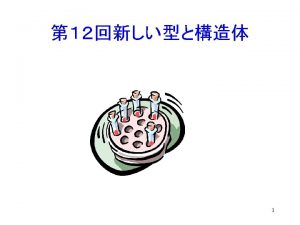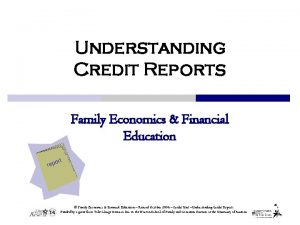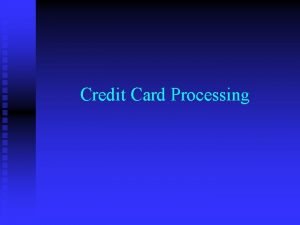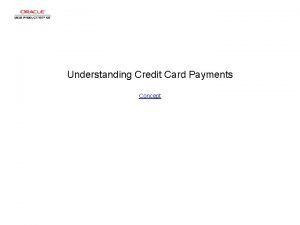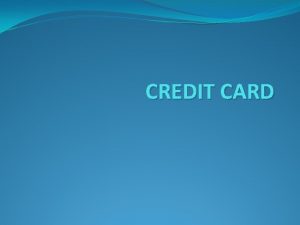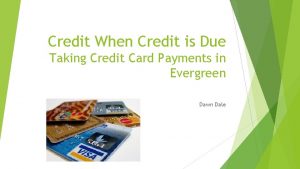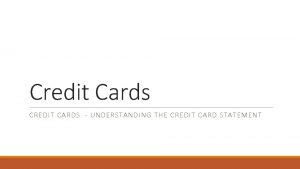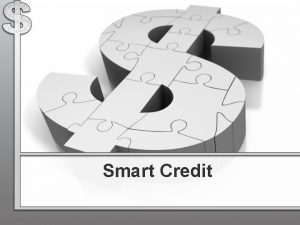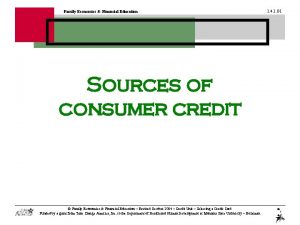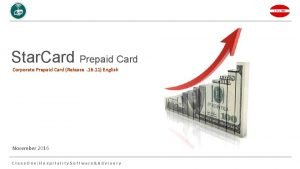Family Economics Financial Education Selecting a Credit Card























- Slides: 23

Family Economics & Financial Education Selecting a Credit Card © Family Economics & Financial Education – Revised October 2004 – Credit Unit – Selecting a Credit Card Funded by a grant from Take Charge America, Inc. to the Norton School of Family and Consumer Sciences at the University of Arizona 1. 4. 1. G 1

Family Economics & Financial Education What is a Credit Card? • Pre-approved credit • Used for purchase of items now • Payment of items later © Family Economics & Financial Education – Revised October 2004 – Credit Unit – Selecting a Credit Card Funded by a grant from Take Charge America, Inc. to the Norton School of Family and Consumer Sciences at the University of Arizona 1. 4. 1. G 1

Family Economics & Financial Education 1. 4. 1. G 1 Statistics • 92% of college students have a credit card by their sophomore year • 1 out of every 5 college students owes between $3, 000 and $7, 000 in credit card debt • Almost half (47%) of all college students carry four or more credit cards (Source: http: //www. fcs. iastate. edu/financial) © Family Economics & Financial Education – Revised October 2004 – Credit Unit – Selecting a Credit Card Funded by a grant from Take Charge America, Inc. to the Norton School of Family and Consumer Sciences at the University of Arizona

Family Economics & Financial Education Why Use a Credit Card? • Advantages • • Convenient Useful for emergencies Often required to hold a reservation Purchase ‘big ticket’ items earlier Easy form of debt consolidation Protection against rip-offs and fraud Establish a good credit rating © Family Economics & Financial Education – Revised October 2004 – Credit Unit – Selecting a Credit Card Funded by a grant from Take Charge America, Inc. to the Norton School of Family and Consumer Sciences at the University of Arizona 1. 4. 1. G 1

Family Economics & Financial Education Why Use a Credit Card? • Disadvantages • • Interest is costly Additional fees are common Tempting to overspend Privacy is an increasing concern Personally responsible for lost/stolen cards Identity theft easier Can lose financial freedom from overspending © Family Economics & Financial Education – Revised October 2004 – Credit Unit – Selecting a Credit Card Funded by a grant from Take Charge America, Inc. to the Norton School of Family and Consumer Sciences at the University of Arizona 1. 4. 1. G 1

Family Economics & Financial Education 1. 4. 1. G 1 Types of Credit Cards • Bank Credit Cards • Flexible account • Accepted anywhere • Available from a financial institution (commercial bank, credit union) with a service provider (Visa, Master. Card) – Electronic network • Retail Credit Cards • Purchases allowed at a particular retailer – i. e. The Buckle or Old Navy • Can work with bank to offer a bank credit card with the retailer’s logo © Family Economics & Financial Education – Revised October 2004 – Credit Unit – Selecting a Credit Card Funded by a grant from Take Charge America, Inc. to the Norton School of Family and Consumer Sciences at the University of Arizona

Family Economics & Financial Education Types of Credit Cards cont. • Travel and Entertainment Cards • Similar to bank credit cards – Can make purchases at a number of businesses • Entire balance must be repaid in 30 days • Prestige Cards • High status accounts • Higher credit qualifications • Special benefits – i. e. Free travelers checks, higher credit limits 1. 4. 1. G 1

Family Economics & Financial Education Types of Credit Cards cont. • Affinity Cards • Accounts through financial institutions • Logo of sponsoring organization – Example: Mothers Against Drunk Driving • Financial institution donates percentage of charges to organization © Family Economics & Financial Education – Revised October 2004 – Credit Unit – Selecting a Credit Card Funded by a grant from Take Charge America, Inc. to the Norton School of Family and Consumer Sciences at the University of Arizona 1. 4. 1. G 1

1. 4. 1. G 1 Family Economics & Financial Education Schumer Box • Fair Truth in Lending Act • Information required by law to inform consumer of all costs associated with use of a credit card Annual Percentage Rate for Purchases Grace Period for Purchases Minimum Finance Charges Balance Calculation Method for Purchases 19. 9% Not less than 25 days $. 50 when a finance charge at a periodic rate is charged Average daily balance method (including new purchases) Annual Fees $20 per year Transaction Fees for Cash Advances 2% with a minimum fee of $3 © Family Economics & Financial Education – Revised October 2004 – Credit Unit – Selecting a Credit Card Funded by a grant from Take Charge America, Inc. to the Norton School of Family and Consumer Sciences at the University of Arizona Late Payment Fees $29

1. 4. 1. G 1 Family Economics & Financial Education Annual Percentage Rate for Purchases 19. 9% Grace Period for Purchases Minimum Finance Charges Balance Calculation Method for Purchases Not less than 25 days $. 50 when a finance charge at a periodic rate is charged Average daily balance method (including new purchases) Annual Fees $20 per year Transaction Fees for Cash Advances Late Payment Fees 2% with a minimum fee of $3 • Annual Percentage Rate (APR) – Interest rate charged for amount borrowed in terms of per dollar per year © Family Economics & Financial Education – Revised October 2004 – Credit Unit – Selecting a Credit Card Funded by a grant from Take Charge America, Inc. to the Norton School of Family and Consumer Sciences at the University of Arizona $29

1. 4. 1. G 1 Family Economics & Financial Education Grace Period Annual Percentage Rate for Purchases Grace Period for Purchases Minimum Finance Charges Balance Calculation Method for Purchases 19. 9% Not less than 25 days $. 50 when a finance charge at a periodic rate is charged Average daily balance method (including new purchases) Annual Fees $20 per year Transaction Fees for Cash Advances Late Payment Fees 2% with a minimum fee of $3 • Grace Period – Amount of time allowed before finance charges are applied © Family Economics & Financial Education – Revised October 2004 – Credit Unit – Selecting a Credit Card Funded by a grant from Take Charge America, Inc. to the Norton School of Family and Consumer Sciences at the University of Arizona $29

1. 4. 1. G 1 Family Economics & Financial Education Minimum Finance Charges Annual Percentage Rate for Purchases Grace Period for Purchases Minimum Finance Charges Balance Calculation Method for Purchases 19. 9% Not less than 25 days $. 50 when a finance charge at a periodic rate is charged Average daily balance method (including new purchases) Annual Fees $20 per year Transaction Fees for Cash Advances Late Payment Fees 2% with a minimum fee of $3 • Minimum Finance Charge – Minimum amount charged for card use © Family Economics & Financial Education – Revised October 2004 – Credit Unit – Selecting a Credit Card Funded by a grant from Take Charge America, Inc. to the Norton School of Family and Consumer Sciences at the University of Arizona $29

1. 4. 1. G 1 Family Economics & Financial Education Balance Calculation Method Annual Percentage Rate for Purchases Grace Period for Purchases Minimum Finance Charges Balance Calculation Method for Purchases 19. 9% Not less than 25 days $. 50 when a finance charge at a periodic rate is charged Average daily balance method (including new purchases) Annual Fees $20 per year Transaction Fees for Cash Advances Late Payment Fees 2% with a minimum fee of $3 • Balance Calculation Method – Method used to determine balance for finance charges © Family Economics & Financial Education – Revised October 2004 – Credit Unit – Selecting a Credit Card Funded by a grant from Take Charge America, Inc. to the Norton School of Family and Consumer Sciences at the University of Arizona $29

Family Economics & Financial Education 1. 4. 1. G 1 Balance Calculation Method cont. • Balance Calculation Method § Average daily balance excluding new purchases – Interest is only paid on the previous balance, not on purchases made since the last payment § Average daily balance including new purchases with a grace period – If the balance is not zero, interest is applied to new purchases when they are made, if the balance is zero, a grace period is allowed before interest is charged © Family Economics & Financial Education – Revised October 2004 – Credit Unit – Selecting a Credit Card Funded by a grant from Take Charge America, Inc. to the Norton School of Family and Consumer Sciences at the University of Arizona

Family Economics & Financial Education 1. 4. 1. G 1 Balance Calculation Method cont. • Balance Calculation Method § Average daily balance including new purchases with no grace period – Regardless of the previous month’s balance, interest is applied to new purchases as they are made § Two-cycle average daily balance including new purchases – This method should be avoided by consumers, as it is the leastbeneficial. The average daily balance is determined on 60 days, rather than 30 days, so finance charges are doubled. A zero balance must be held for two months in order to avoid charges © Family Economics & Financial Education – Revised October 2004 – Credit Unit – Selecting a Credit Card Funded by a grant from Take Charge America, Inc. to the Norton School of Family and Consumer Sciences at the University of Arizona

1. 4. 1. G 1 Family Economics & Financial Education Annual Fees Annual Percentage Rate for Purchases Grace Period for Purchases Minimum Finance Charges Balance Calculation Method for Purchases 19. 9% Not less than 25 days $. 50 when a finance charge at a periodic rate is charged Average daily balance method (including new purchases) Annual Fees $20 per year Transaction Fees for Cash Advances 2% with a minimum fee of $3 • Annual Fees – Yearly charge for credit card ownership © Family Economics & Financial Education – Revised October 2004 – Credit Unit – Selecting a Credit Card Funded by a grant from Take Charge America, Inc. to the Norton School of Family and Consumer Sciences at the University of Arizona Late Payment Fees $29

1. 4. 1. G 1 Family Economics & Financial Education Cash Advances Annual Percentage Rate for Purchases Grace Period for Purchases Minimum Finance Charges Balance Calculation Method for Purchases 19. 9% Not less than 25 days $. 50 when a finance charge at a periodic rate is charged Average daily balance method (including new purchases) Annual Fees $20 per year Transaction Fees for Cash Advances 2% with a minimum fee of $3 Late Payment Fees $29 • Cash Advance Transaction Fees – Cash withdrawal fees © Family Economics & Financial Education – Revised October 2004 – Credit Unit – Selecting a Credit Card Funded by a grant from Take Charge America, Inc. to the Norton School of Family and Consumer Sciences at the University of Arizona

1. 4. 1. G 1 Family Economics & Financial Education Late Payment Fees Annual Percentage Rate for Purchases Grace Period for Purchases Minimum Finance Charges Balance Calculation Method for Purchases 19. 9% Not less than 25 days $. 50 when a finance charge at a periodic rate is charged Average daily balance method (including new purchases) Annual Fees $20 per year Transaction Fees for Cash Advances 2% with a minimum fee of $3 Late Payment Fees $29 • Late Payment Fees – Penalty fee for payments not made by the due date © Family Economics & Financial Education – Revised October 2004 – Credit Unit – Selecting a Credit Card Funded by a grant from Take Charge America, Inc. to the Norton School of Family and Consumer Sciences at the University of Arizona

Family Economics & Financial Education Opening a Credit Account 1. 2. 3. 4. 5. Applicant completes a credit application Lender conducts a credit investigation Applicant is given a credit rating Lender accepts or denies the credit request If accepted, applicant evaluates the credit card details 6. Applicant accepts or refuses credit terms © Family Economics & Financial Education – Revised October 2004 – Credit Unit – Selecting a Credit Card Funded by a grant from Take Charge America, Inc. to the Norton School of Family and Consumer Sciences at the University of Arizona 1. 4. 1. G 1

Family Economics & Financial Education 1. 4. 1. G 1 Understanding the Bill • Minimum Payment Due – The minimum amount to be paid § If this amount is paid and a balance is left on the account, additional finance charges will be included in the following month’s balance • Past Due Amount – The required amount not paid before the due date • Due Date – The day by which the company requires a payment to be made • New Balance – The total amount owed on a credit card © Family Economics & Financial Education – Revised October 2004 – Credit Unit – Selecting a Credit Card Funded by a grant from Take Charge America, Inc. to the Norton School of Family and Consumer Sciences at the University of Arizona

Family Economics & Financial Education 1. 4. 1. G 1 Understanding the Bill cont. • Credit Line – The maximum amount of charges allowed to an account • Closing Date – Last day for transactions to be reported on the statement • Charges, Payments, and Credits – The transactions which occur with the use of a credit card • Finance Charge – Charges assessed for credit card use © Family Economics & Financial Education – Revised October 2004 – Credit Unit – Selecting a Credit Card Funded by a grant from Take Charge America, Inc. to the Norton School of Family and Consumer Sciences at the University of Arizona

Family Economics & Financial Education Using a Credit Card Properly • Only use a card when there is no doubt about ability to pay off the charges at the end of the billing cycle • Record all expenses and keep receipts • Check credit statement for errors • Always pay off balance completely and timely © Family Economics & Financial Education – Revised October 2004 – Credit Unit – Selecting a Credit Card Funded by a grant from Take Charge America, Inc. to the Norton School of Family and Consumer Sciences at the University of Arizona 1. 4. 1. G 1

Family Economics & Financial Education Safety Tips • Sign card with signature and “Please See ID” • Do not leave cards lying around • Close unused accounts in writing and by phone, then cut up the card • Do not give out account number unless making purchases • Keep a list of all cards, account numbers, and phone numbers separate from cards • Report lost or stolen cards promptly © Family Economics & Financial Education – Revised October 2004 – Credit Unit – Selecting a Credit Card Funded by a grant from Take Charge America, Inc. to the Norton School of Family and Consumer Sciences at the University of Arizona 1. 4. 1. G 1
 Selecting text means selecting
Selecting text means selecting Family economics and financial education
Family economics and financial education Doris norton
Doris norton Family economics and financial education
Family economics and financial education 3 1 checking accounts worksheet answers
3 1 checking accounts worksheet answers Disadvantages of debit card
Disadvantages of debit card This can be avoided by giving credit where credit is due.
This can be avoided by giving credit where credit is due. University of washington credit card
University of washington credit card Rbfcu netbranch
Rbfcu netbranch Mythbusters credit card
Mythbusters credit card Wells fargo payment gateway
Wells fargo payment gateway Ravi credit card
Ravi credit card Credit card trivia
Credit card trivia Raspberry pi credit card
Raspberry pi credit card Credit card statement worksheet answers
Credit card statement worksheet answers What is upc
What is upc Tomika's credit rating was lowered
Tomika's credit rating was lowered Credit card 101
Credit card 101 Vnotify
Vnotify 4-5 credit card statement
4-5 credit card statement Kayes credit card
Kayes credit card 3-6 credit card statement answers
3-6 credit card statement answers Unicredit consumer financing
Unicredit consumer financing Santander 123 world
Santander 123 world




